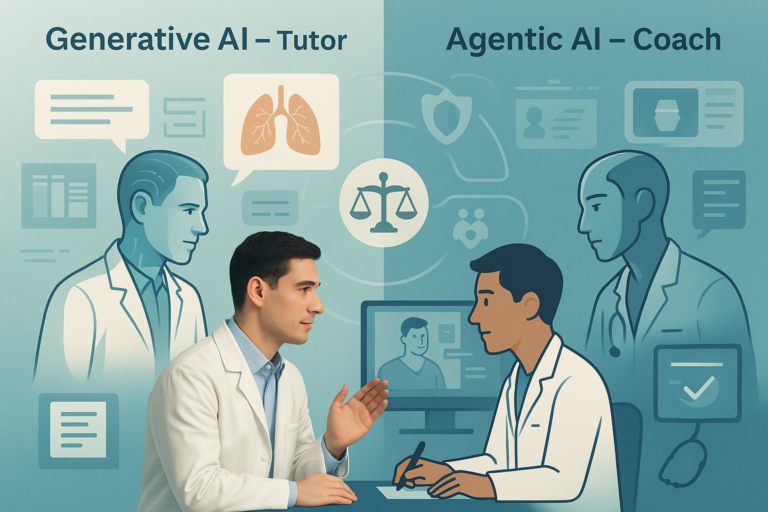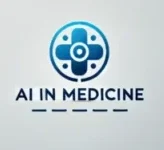
Introduction: Medical training is at a pivotal moment, with generative AI already reshaping educational practices as reliable, on-demand tutors that deliver instant knowledge and feedback, while agentic AI is poised to further revolutionize medical training as proactive, autonomous coaches guiding learners through dynamic clinical scenarios. Together, these AI paradigms offer complementary benefits in educating future physicians, but realizing their full potential requires a clear understanding of their distinct roles, thoughtful integration, and careful attention to critical ethical considerations.
As medical education increasingly incorporates AI, frameworks such as the Association of American Medical Colleges (AAMC) Principles for the Responsible Use of Artificial Intelligence highlight essential guidelines for effectively and ethically integrating these technologies. These principles emphasize human-centered approaches, ethical transparency, equitable access, interdisciplinary curriculum development, privacy protection, and continuous monitoring and evaluation of AI tools in educational settings.
The following sections explore these AI paradigms in greater depth, highlighting how their technological differences shape their practical use in medical education, and discussing the ethical and humanistic factors critical to their successful and responsible integration.
Generative vs Agentic AI in Medical Training
From an engineering perspective, generative AI systems primarily rely on transformer architectures trained for next-token prediction, optimized for static input-output mappings. In contrast, agentic AI systems incorporate reinforcement learning, environment modeling, and task orchestration to support autonomy, goal-directed behavior, and temporal reasoning across interactive states.
Understanding these fundamental technological differences sets the stage for recognizing how each AI modality uniquely contributes to medical education.
Generative AI, exemplified by tools like ChatGPT, excels at personalized, interactive instruction, responding passively but effectively to learner queries. It disseminates knowledge widely and instantly, making it highly accessible and scalable. In contrast, agentic AI proactively simulates complex clinical environments, offering real-time feedback and dynamically engaging learners in practical, hands-on decision-making scenarios.
Generative AI is already widely integrated into contemporary medical education, particularly for generating practice questions, clarifying complex medical concepts, and providing immediate educational feedback. Conversely, agentic AI remains primarily experimental, existing mostly in pilot programs and controlled simulations. While promising, broader integration of agentic AI into standard curricula is realistically anticipated within the next 5–10 years, contingent upon robust technological validation and the establishment of comprehensive ethical frameworks.
Aligning these emerging technologies with structured frameworks, such as those provided by the AAMC, will be crucial to navigating their effective and ethical integration into medical curricula.
To illustrate these distinctions and potential synergies clearly, we examine a clinical scenario involving generative and agentic AI.
Clinical Vignette: Preparing for Objective Structured Clinical Examinations (OSCEs)
Consider a second-year medical student, Alex, preparing for an upcoming Objective Structured Clinical Examination (OSCE). Initially, Alex uses a generative AI tutor to strengthen foundational knowledge of clinical protocols and patient communication strategies. The generative AI tutor provides immediate, personalized answers and detailed explanations, reinforcing Alex’s comprehension and boosting confidence. For example, Alex queries the AI about appropriate physical examination techniques, clinical reasoning, and common patient scenarios. The AI tutor quickly synthesizes current guidelines, clearly explains procedural steps, and offers illustrative case examples, significantly enhancing Alex’s preparedness.
Next, Alex engages in a realistic simulation guided by an agentic AI coach. The scenario simulates a standardized patient encounter, dynamically adjusting based on Alex’s clinical decisions and communication skills. Initially, Alex manages patient interaction smoothly, asking relevant questions and addressing patient concerns effectively. However, when Alex hesitates in deciding on appropriate diagnostic tests, the agentic AI coach promptly intervenes with adaptive prompts, suggesting critical actions based on the evolving patient presentation. Responding to this feedback, Alex refines the decision-making process and selects appropriate diagnostic measures, prompting the virtual patient’s responses to reflect realistic clinical outcomes. Following the session, the agentic AI provides a detailed, individualized debrief, identifying strengths and specific areas for improvement, such as clinical reasoning speed and the accuracy of diagnostic decisions.
Together, these AI systems complement each other effectively: generative AI consolidates foundational knowledge, while agentic AI offers practical, real-world experience, reinforcing critical thinking, adaptability, and the decision-making skills crucial for clinical proficiency.
While the integration of these AI tools promises significant educational benefits, it simultaneously introduces critical ethical considerations and responsibilities.
Ethical Considerations and Responsibilities
As medical educators increasingly incorporate AI into curricula, explicitly addressing ethical concerns becomes paramount. A recent survey conducted by Ichikawa et al., involving respondents from 43 osteopathic medical schools (representing 85% of U.S. osteopathic programs with a 75% response rate), highlighted substantial gaps in institutional readiness for AI integration (1). Specifically, 93% of these schools have no established policies regarding generative AI use among students, and 79% have no plans to develop such policies. Similarly, no institutions reported established generative AI policies for faculty or administrators, with 80% lacking formal plans to create these guidelines. Survey limitations include potential response bias and variability in respondents’ familiarity with institutional AI policies, further emphasizing the urgent need for robust policy development to manage ethical implications effectively.
Medical education must prioritize transparency regarding AI capabilities and limitations, actively mitigating biases inherent in training datasets, ensuring equitable access to technology, and fostering ethical understanding among learners. Institutions must also establish rigorous oversight to safeguard learner trust and patient safety, ultimately harnessing AI’s full educational potential ethically and responsibly.
Despite technological advancements, maintaining the essential human element in medical training remains paramount.
Preserving the Human Element
As we integrate AI into medical education, preserving the human core of medicine becomes increasingly important. While AI can support and enhance educational practices, it cannot replicate the uniquely human experiences that foster empathy, ethical judgment, and reflective learning. These essential qualities emerge not from algorithms, but from real-world interactions, introspection, and the moral growth inherent in caring for patients.
The renowned surgeon Dr. William J. Mayo articulated this enduring human dimension eloquently when reflecting on medicine’s continual evolution: “The glory of medicine is that it is constantly moving forward, that there is always more to learn. The ills of today do not cloud the horizon of tomorrow, but act as a spur to greater effort.”(2). Mayo’s perspective highlights the optimistic and human-centered approach necessary for responsibly embracing AI. It reminds us that the true essence of medical education lies not in the sophistication of tools we employ, but in our ongoing commitment to nurturing compassionate, reflective, and ethically responsible physicians.
Conclusion
Generative and agentic AI represent two complementary pathways transforming medical education. The synergy between accessible, knowledge-rich generative AI and adaptive, experience-driven agentic AI promises a robust educational paradigm. By proactively addressing ethical concerns, medical educators can ensure AI technologies support the development of competent, compassionate, and ethically responsible physicians. Together, these technologies hold the promise not only to enhance learning but also to inspire innovation, equipping future physicians with both the knowledge and practical skills essential for excellent patient care in an evolving medical landscape. As we stand at the threshold of this AI-enhanced era, the question is not whether medicine will embrace AI, but how boldly and ethically we will guide its course.
Disclaimer: This manuscript was written by the author, with assistance from OpenAI’s ChatGPT 4.5 for language editing and clarity improvements.
References
1.Ichikawa T, Olsen E, Vinod A, Glenn N, Hanna K, Lund GC, et al. Generative artificial intelligence in medical education—policies and training at us osteopathic medical schools: Descriptive cross-sectional survey. JMIR Medical Education. 2025;11(1):e58766.
2.Mayo W. The aims and ideals of the american medical association. Proceedings and Addresses of the National Education Association; 1928, pp. 158-63.
